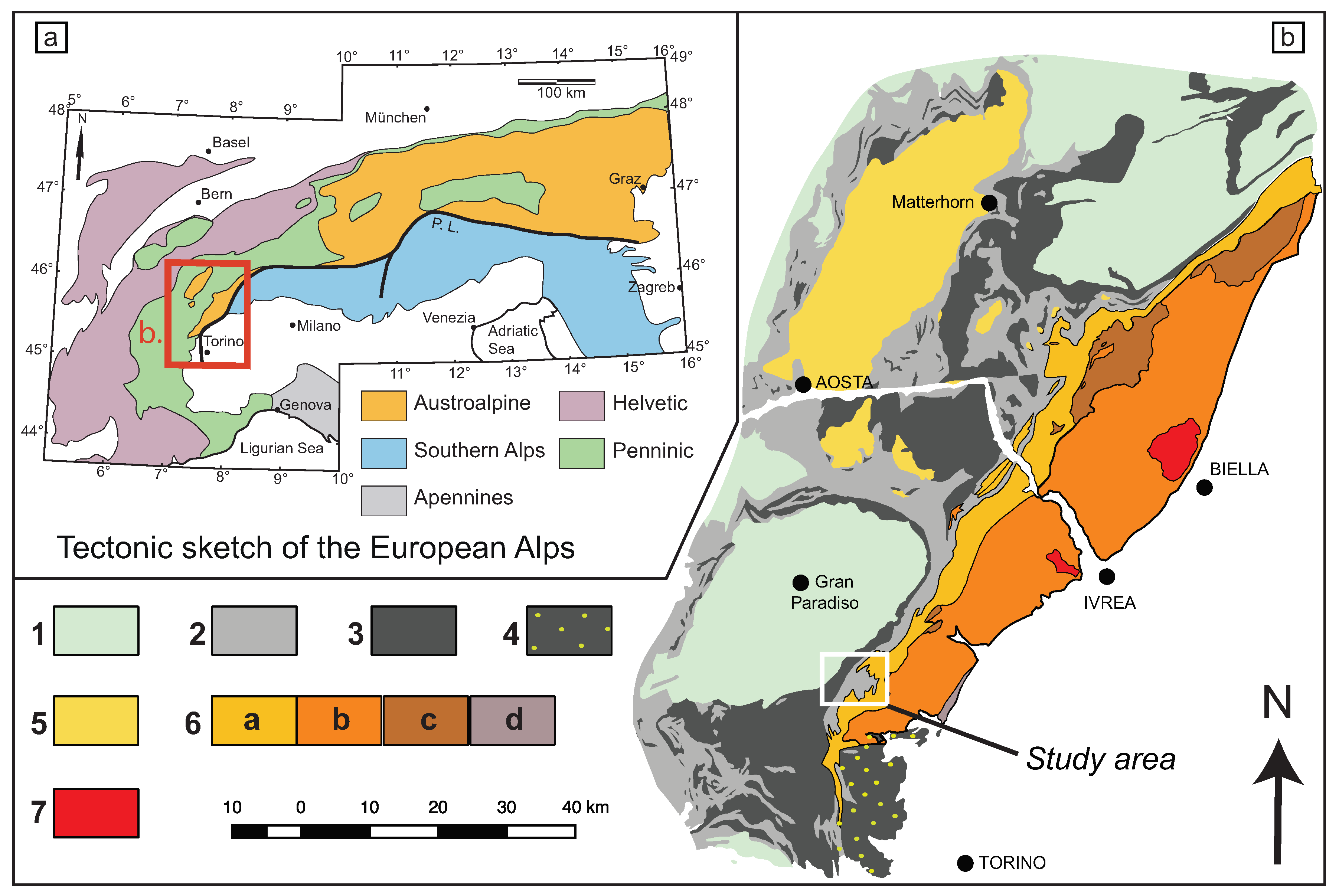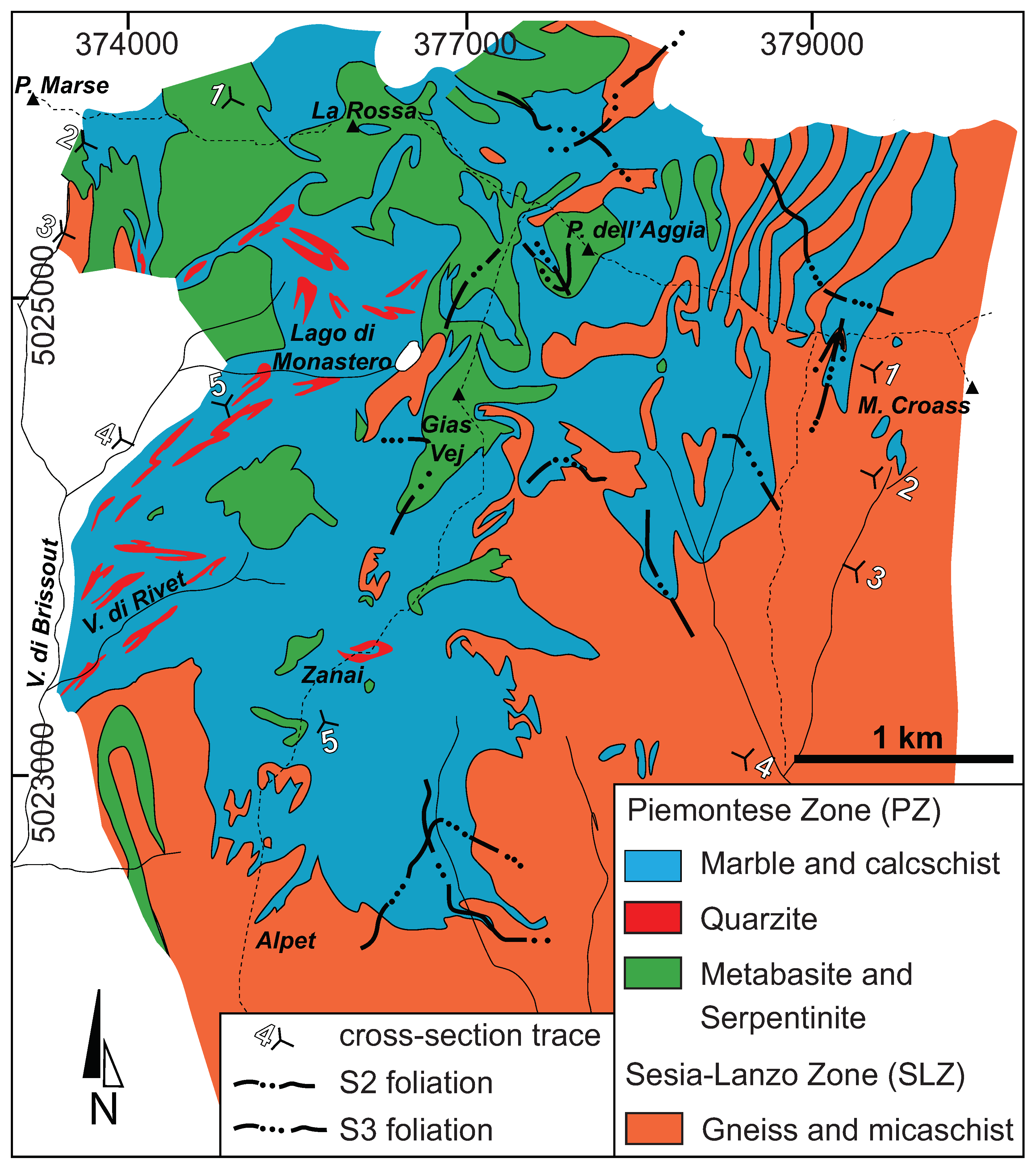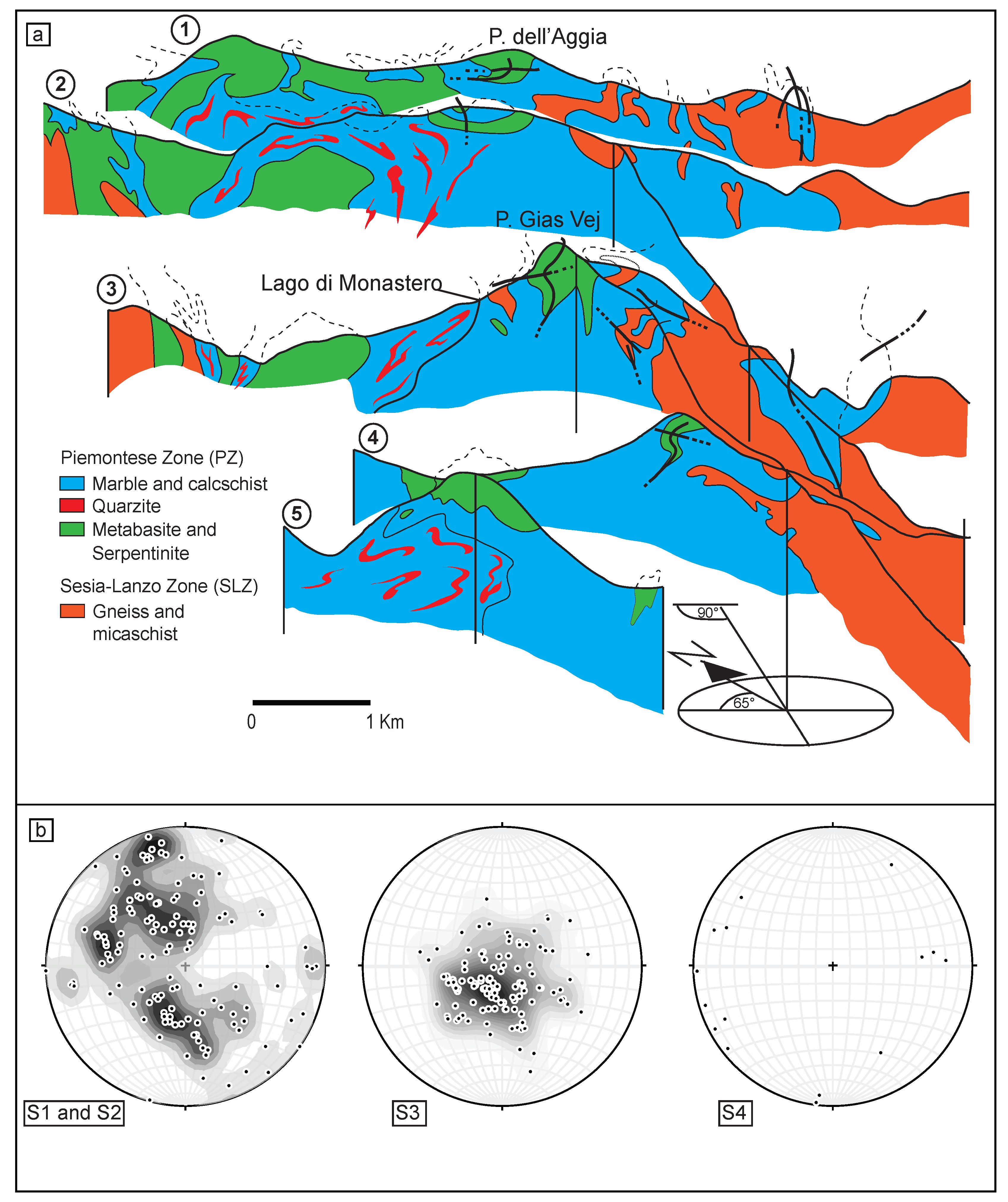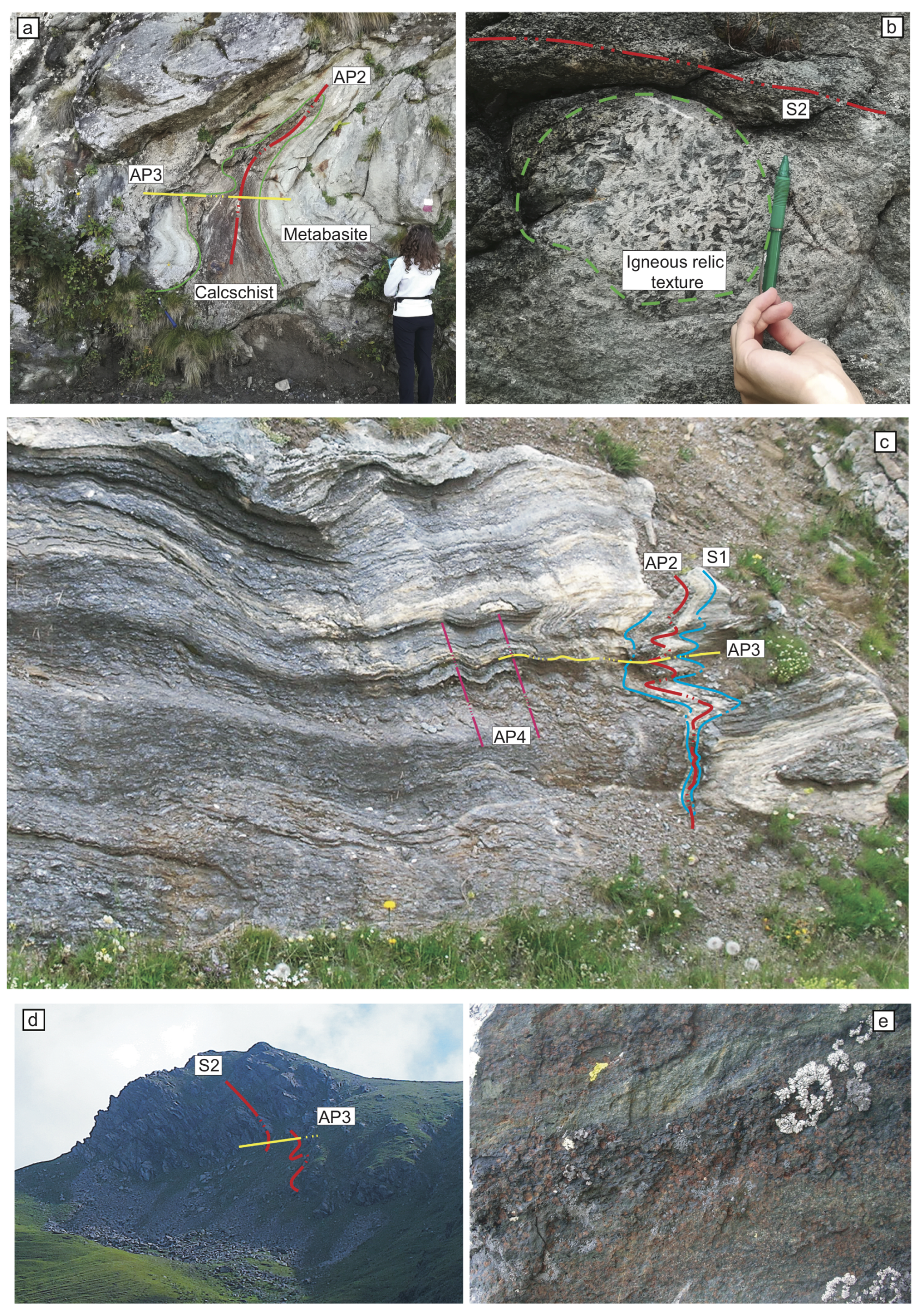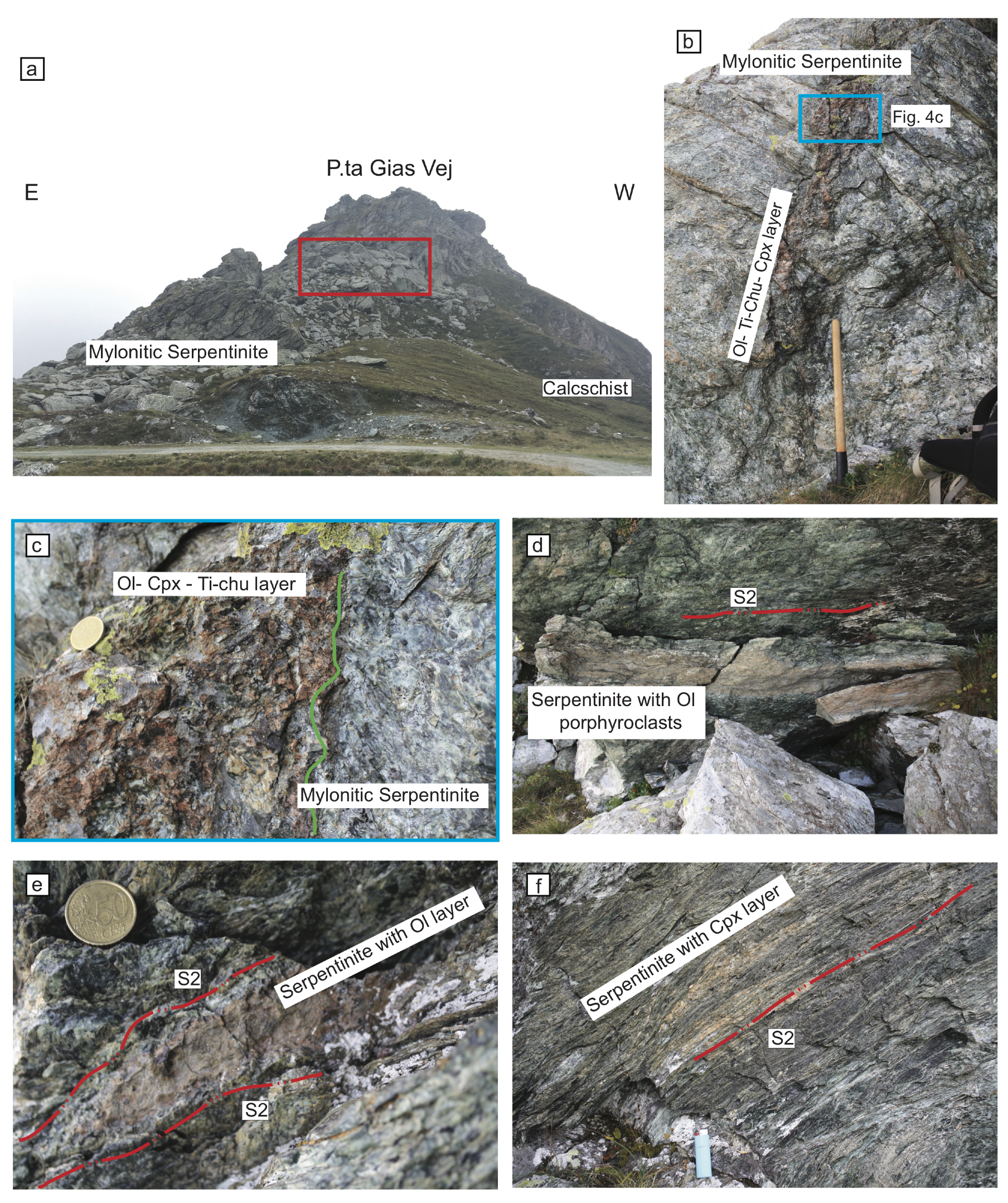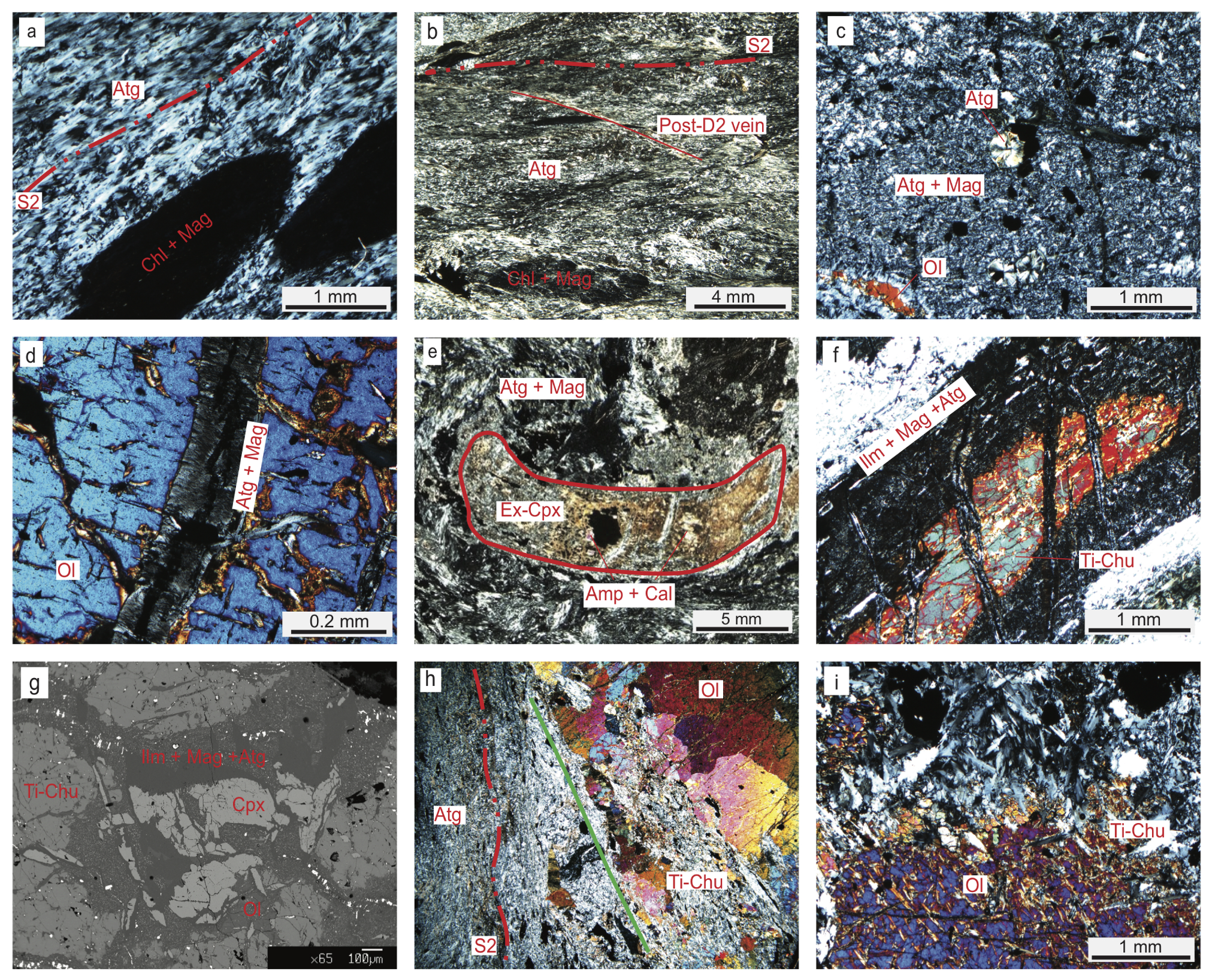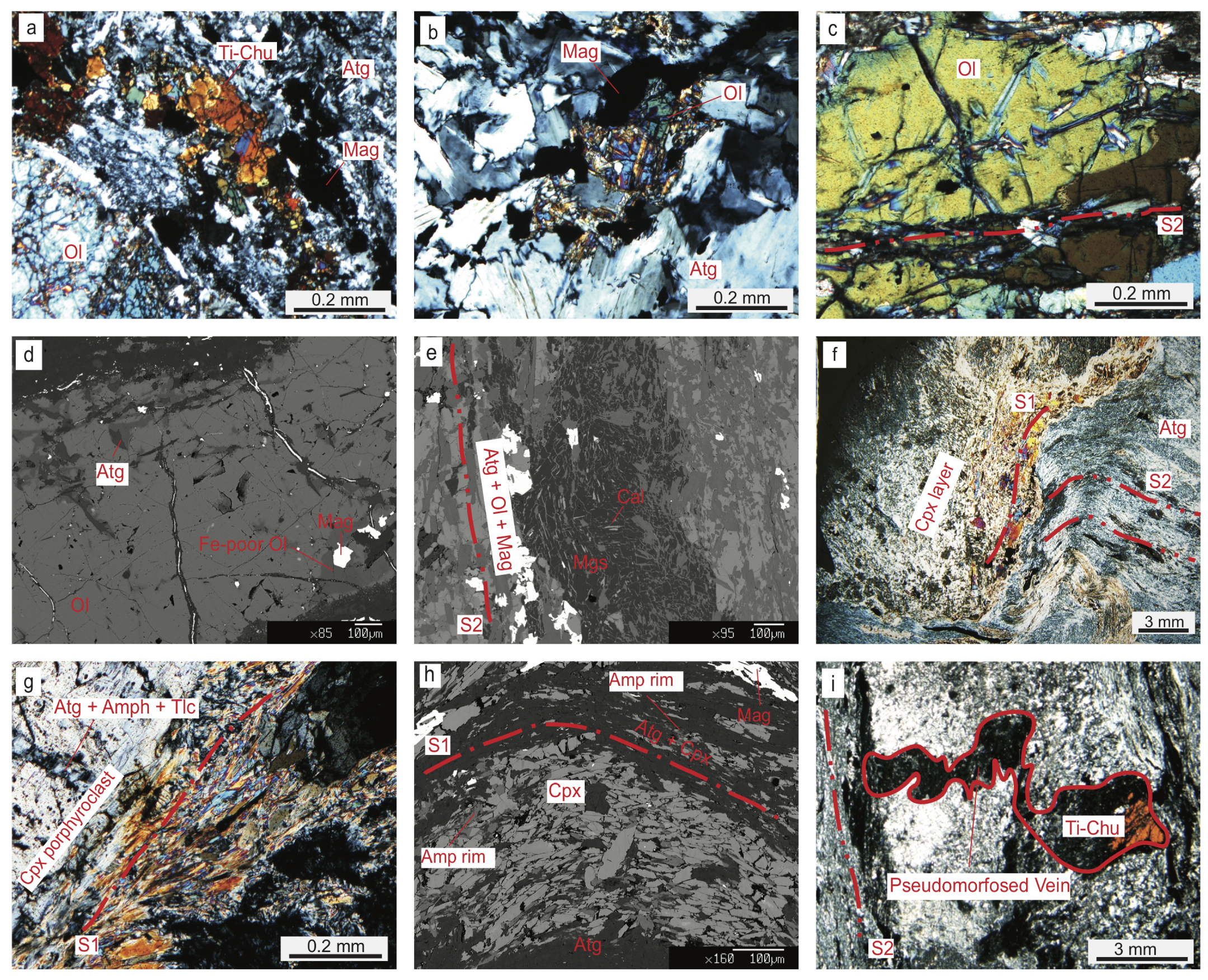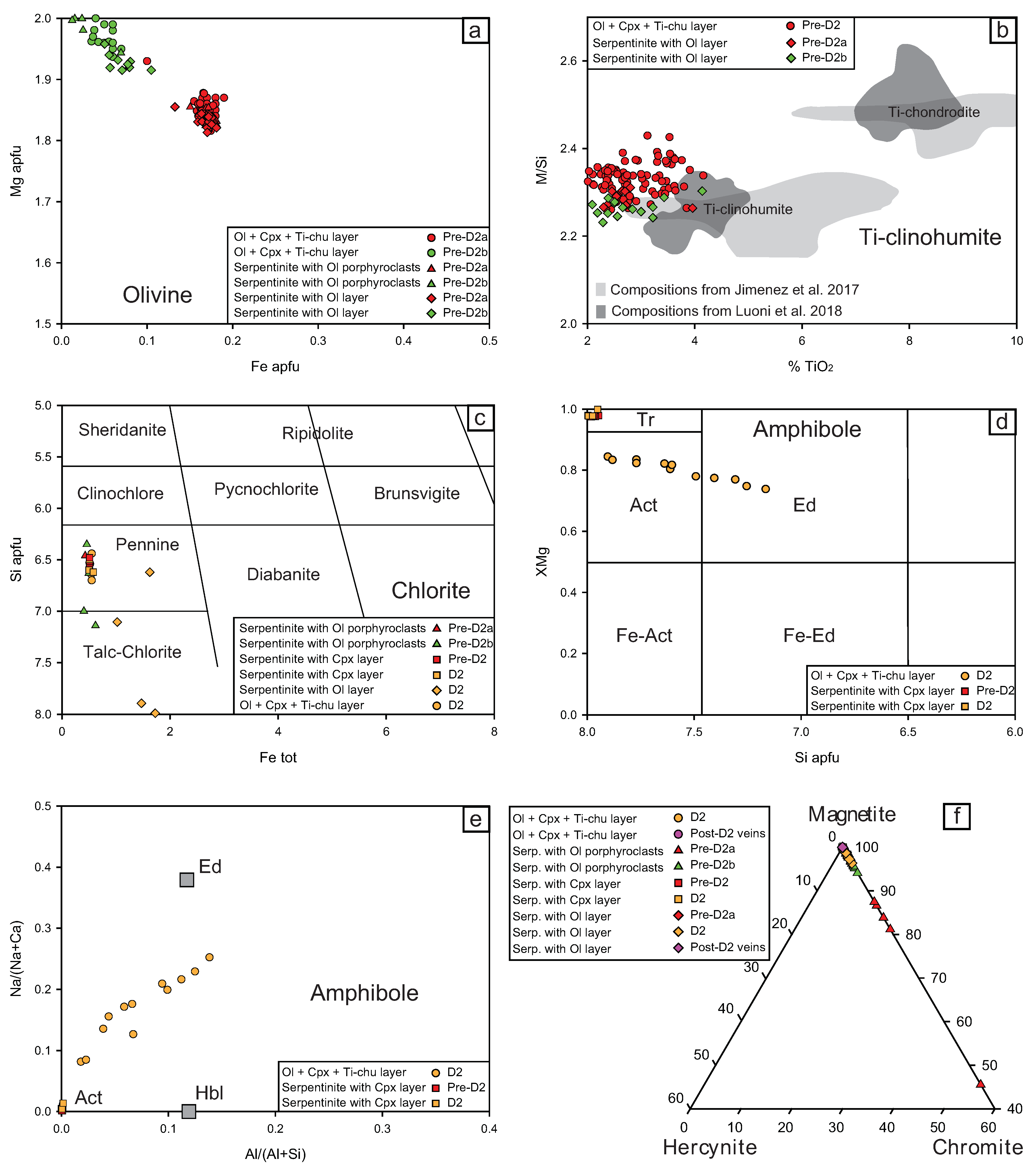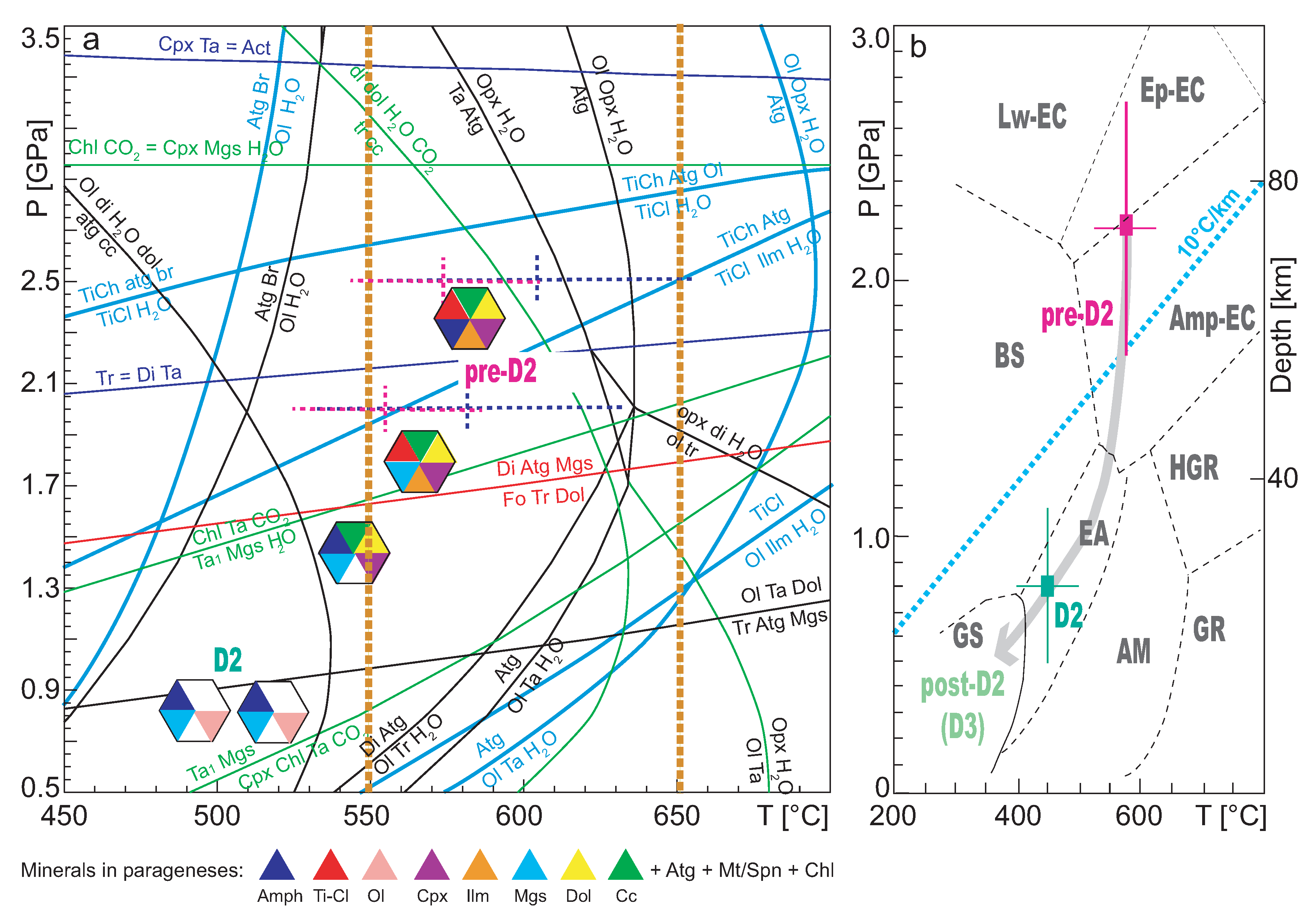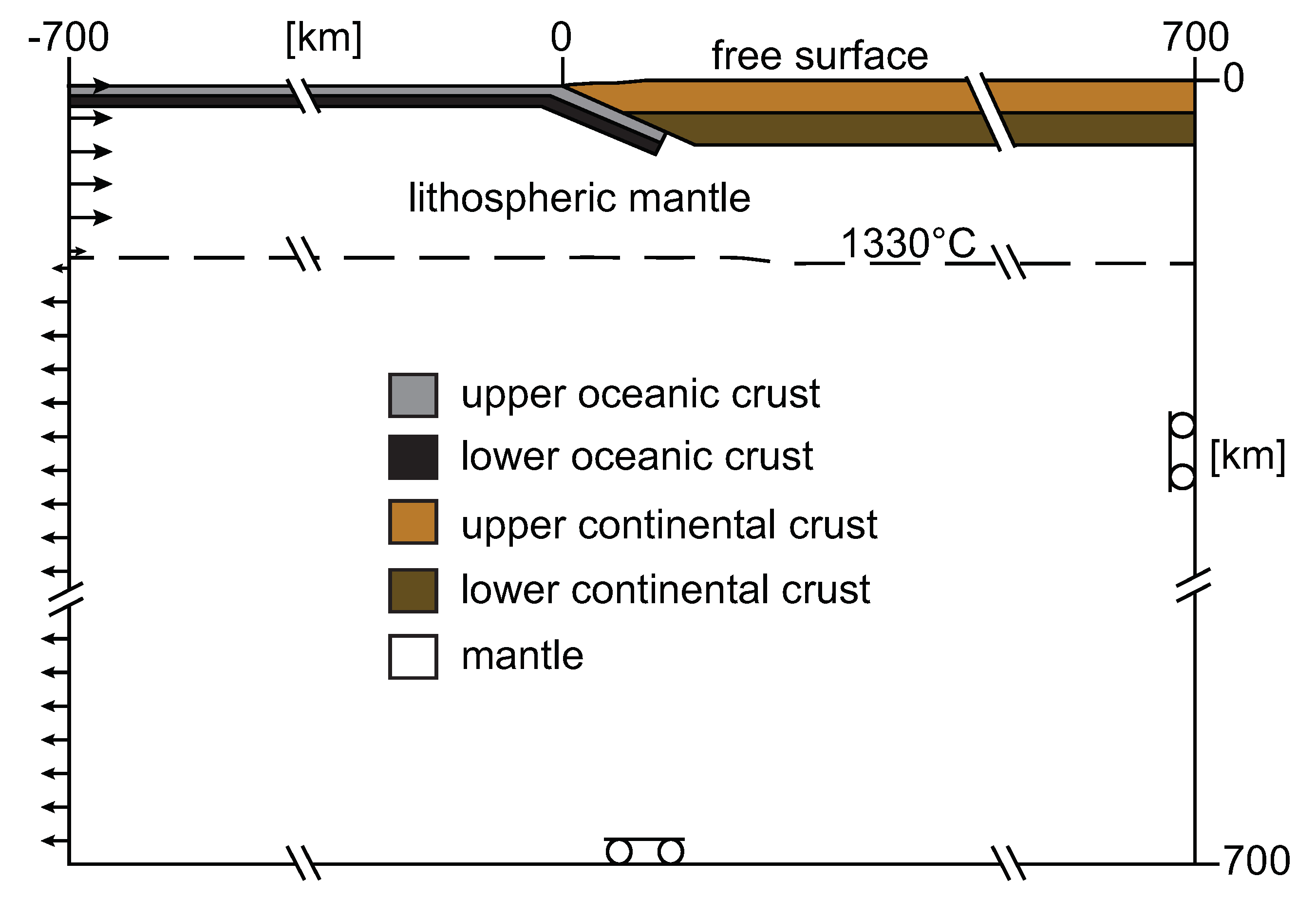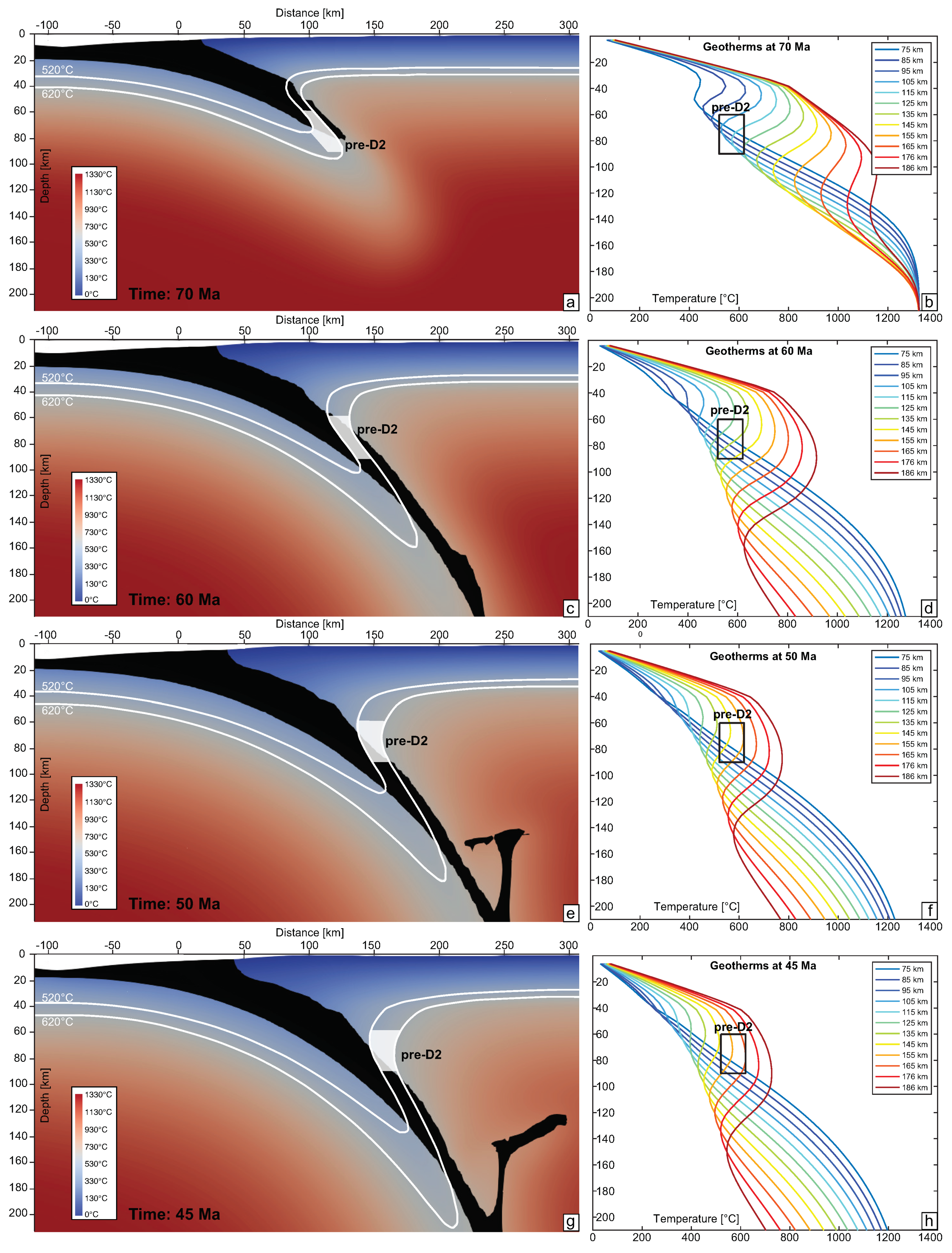1. Introduction
The Piemonte Zone of the Western Alps comprises the ophiolitic remnants of the Ligurian-Piedmont Ocean, dismembered by the polyphase tectono-metamorphic evolution recorded during the Alpine convergence e.g., [
1,
2,
3,
4,
5,
6,
7,
8]. Even though some authors consider the ophiolites of the Piemonte zone as lithospheric fragments of a magma-poor ocean-continent transition zone of the Tethys e.g., [
9,
10,
11], they are widely interpreted as derived from the Ligurian-Piedmont oceanic lithosphere, [
7] and refs. therein, since they have chemical, structural and lithostratigraphic characters similar to those of a subduction-unrelated oceanic lithosphere [
12].
At the boundary between the Piemonte Zone (PZ) metaophiolites and the Austroalpine continental crust (
Figure 1a,b), a tectonic mixing of thin slivers of calcschists, quartzites, metabasites, serpentinites and fine-grained gneisses (metapelites and metagranitoids) occurs all along the western margin of the central and southern Sesia-Lanzo Zone (SLZ), extending over a distance of 50 km, from Santanel klippe to Lanzo Massif [
13,
14,
15,
16]. This portion of PZ, deeply entwined with the SLZ continental crust, shows heterogeneous metamorphic evolutions with climax conditions ranging from greenschist- to eclogite-facies conditions [
13,
15,
17].
The Lago di Monastero-Punta Gias Vej area (Lanzo Valleys) offers the observation of the articulated boundary between the PZ and SLZ, a dense interlocking of ophiolitic and continental material, produced by the Alpine subduction-related structural evolution [
13], in which slices of serpentinite are quite common (
Figure 2 and
Figure 3a). As recently shown, in the axial portion of orogenic belts serpentinites are useful tools to unravel the oceanic and orogenic evolution of meta-ophiolite in subduction complexes e.g., [
8,
18,
19,
20,
21,
22].
Our goal is to unravel the PTdt evolution of Punta Gias Vej serpentinite from the Lanzo Valleys subduction complex, and to explore whether this evolution can be achieved during an ocean/continent subduction. For this purpose the inferred tectono-thermal peak conditions will be compared with the predictions of a 2D numerical simulation of an ocean/continent subduction system, at different time steps, in order to give clues about the time and the paleogeography of peak conditions.
2. Geological Setting
The axial zone of the Western Alps (
Figure 1a), comprised between the Periadriatic Lineament and the Penninic Front, contains units of continental and oceanic origin tectonically mixed during burial and exhumation consequent to the Alpine subduction and collision e.g., [
23,
24,
25,
26,
27,
28,
29,
30,
31]. The investigated serpentinites are located in the Lanzo Valleys (upper part of the Tesso Valley): the main masses occur in hundreds meter-sized bodies between Punta Gias Vej and Punta dell’Aggia, where the rocks of the ophiolitic PZ (Penninic domain) are tectonically interlocked with the continental rocks of the SLZ (Austroalpine domain), just north of the Lanzo Massif (
Figure 1b,
Figure 2 and
Figure 3a).
In the PZ two different types of ophiolites have been distinguished in the Aosta Valley (northern portion of the Western Alps) on the basis of the lithological association and metamorphic assemblages, namely the Combin and Zermatt-Saas Zones, that correspond to the Upper and Lower Piemonte Zones, respectively, in the southern part of the Western Alps e.g., [
5,
32]. The Combin-type, or Upper Piemonte Zone, ophiolite sequence mainly comprises carbonate to terrigenous flysch-type metasediments, commonly including intercalations of metabasites and minor serpentinite slices [
2,
32,
33]. Usually the top of the ophiolitic sequence is dominated by manganiferous quartzites and other oceanic sediments [
34,
35]. The dominant metamorphic imprint is recorded under greenschist-facies conditions, with mica ages at 36–40 Ma e.g., [
36], although some relics of epidote-blueschist-facies minerals have been described e.g., [
33,
35,
37,
38].
The Zermatt-Saas-type, or Lower Piemonte Zone, ophiolite sequence consists of huge ultramafic and mafic bodies and minor associated metasedimentary cover; serpentinites are the most abundant rocks, often enclosing rodingite bodies [
39,
40,
41,
42,
43,
44,
45,
46,
47]. Mafic rocks are Mg- and Fe- gabbros and metabasalts, locally preserving primary textures, such as pillow lavas [
48,
49,
50,
51], with a normal-MORB signature and recording a HP-UHP dominant metamorphic imprint see references in [
5,
6,
7,
32]. The metasedimentary cover comprises quartzites, marbles and calcschists [
34,
52,
53,
54,
55,
55]. Eclogite-facies metamorphic imprint is dominant in all the lithotypes and widely documented [
51,
53,
56,
57,
58] and references therein, and UHP assemblages have been recognized i.e., Cignana and Valtournanche [
21,
54,
59,
60]. The ages of the protoliths are Jurassic and the HP metamorphism is generally dated between 70 and 40 Ma (see
Table 1 and references therein).
In the Lanzo Valleys, rocks from the PZ are mixed with those of the SLZ continental crust, and show variable lithostratigraphic settings and heterogeneous metamorphic evolutions, with climax conditions ranging from greenschist-facies in the Middle Orco Valley, where metasediments dominate [
15], to eclogite-facies conditions in the Lanzo Valleys, where slices of eclogites, metagabbros, variably re-equilibrated metabasites and serpentinites are mingled with calcschists and quartzites, together with slices of SLZ gneisses [
13]. The Lanzo Valleys intersect the southernmost portion of the SLZ (
Figure 1b), the largest portion of continental crust from the Austroalpine domain eclogitized during the Alpine convergence e.g., [
23,
30,
86,
87,
88,
89]. To the West it is bounded by the PZ, to the East by the Canavese Lineament and to the South by the Lanzo Massif. The rocks of the SLZ have been exhumed to shallow crustal levels before the continental collision and the emplacement of the Biella and Traversella Tertiary plutons e.g., [
28,
90,
91].
The SLZ is classically divided into four complexes: the II Dioritic-Kinzigitic Zone (IIDK), the Gneiss Minuti Complex (GMC), the Eclogitic Micaschists Complex (EMC) and the Rocca Canavese Thrust Sheets (RCT). The IIDK is constituted by metapelites and metabasites and preserves a pervasive pre-Alpine HT metamorphic imprint [
86,
92,
93,
94,
95]. The GMC and the EMC consist of metapelites, metagranitoids, metabasites, ultramafics and impure marbles, and display a dominant Alpine metamorphic imprint that developed under greenschist-facies conditions in the GMC and under eclogite-facies conditions in the EMC. Both complexes locally preserve HT pre-Alpine mineral relics, and in the GMC, eclogitic relic assemblages of early Alpine age are sheltered in metapelites, metabasites and metagranitoids. These two complexes recorded heterogeneous Alpine metamorphic histories, among which it is discontinuously possible to recognize the record of a prograde blueschist-facies imprint, overprinted by eclogite-facies imprint, and successively re-equilibrated under blueschist- and greenschist-facies conditions. The Alpine metamorphic history developed under a low T/depth ratio (<10
C/km), compatible with cold subductions, which persisted until the exhumation of the SLZ e.g., [
13,
23,
86,
87,
88,
94,
96,
97,
98,
99,
100,
101,
102,
103,
104,
105,
106,
107,
108,
109]. The RCT is characterized by pre-Alpine continental and upper mantle rocks with a climax Alpine metamorphic imprint under blueschist-facies conditions; here no relics of eclogite-facies assemblages have been described to date [
101,
110,
111,
112,
113,
114,
115]. Mineral ages interpreted as related to the Alpine HP metamorphism vary between 90 and 65 Ma [
81,
91,
109,
116,
117,
118,
119], whereas the greenschist-facies re-equilibration predates Biella and Traversella plutons emplacement [
90,
106] and therefore is older than 41–42 Ma [
120].
As mentioned above the investigated serpentinites are located in the Lanzo Valleys, more precisely in the northern Tesso Valley (Punta Gias Vej) at the southern border between the SLZ and the PZ (white square in
Figure 1b), not far from the triple junction between these two domains and the Lanzo Ultramafic Massif [
121,
122,
123,
124] and references therein. Here, the PZ is constituted by serpentinites with minor ophicalcites and rodingites, metabasites with relics of omphacite-bearing metagabbros and eclogites, calcschists, grey and white marbles and quartzites [
13]. The SLZ comprises metagranitoids, metapelites, tholeiitic to alkaline metagabbros and metabasites that recorded eclogite-facies metamorphism [
13,
104,
125,
126].
The boundary between the PZ and the SLZ is deformed and four groups of superposed ductile structures have been detected (
Figure 2 and
Figure 3a) [
13]. Rootless isoclinal folds are associated with a pervasive S1 foliation (D1 structures); D2 structures are tight to isoclinal folds associated with a dominant S2 foliation. D3 comprises tight to open folds showing various styles depending on different rock rheology: tight folds and crenulation cleavage occur in calcschists whereas open folds develop in quartzites, without a new differentiated axial plane foliation. D4 gentle folds have sub-vertical axial planes, locally associated with a disjunctive cleavage.
3. Mesostructures
During field-work four groups (D1-D4;
Figure 2,
Figure 3 and
Figure 4) of superposed ductile structures have been recognized in both continental and oceanic affinity rocks, coherently with the structural outline of previous work [
13]. D1 structures comprise up to meter size isoclinal rootless D1 folds, generally intrafolial and responsible for the strong disruption of rock layers. These folds are associated with a pervasive axial plane foliation (S1) showing very variable orientation, due to successive refolding (
Figure 3b).
D2 tight to isoclinal folds with sub-vertical axial planes are associated with an axial plane foliation (S2) that is the dominant fabric at the kilometer scale, mainly dipping 50
towards NE (
Figure 3b and
Figure 4b–d). S2 is a variably differentiated crenulation cleavage.
D3 folds are open, with sub-horizontal axial planes generally dipping 30
towards NW (
Figure 3b and
Figure 4a–d). During D3 a pervasive axial plane foliation does not develop and when it is present, it is generally associated with chevron-like folds. D3 structures have a constant spatial orientation throughout the area and the weak local dispersions are due to the refraction induced by rock viscosity contrasts. Locally, D3 shear zones develop with mylonitic texture. D4 is testified by long-wavelength undulations, with sub-vertical axial planes, that are less pervasive than D2 and D3 folds.
Schmidt’s projections show two specular bundles of data that reflect the hips of the undulations (
Figure 3b). The interference patterns between the D2 and D3 folds are always of type 3 [
127], while those between D3 and older folds (the latter rarely distinguishable from each other due to the local lack of direct overlapping between D2 and D1) are both of type 3 and 2. Interference patterns between D4 folds and the older ones have rarely been observed, and locally D4 fold axes show an angle of 40–60
with D2 and of 25–40
with D3 fold axes. Interference pattern of type 3 between D4 and D1 or D2 and D1 folds are locally observed. All these characters suggest a strong disruption and reorientation of the oldest folds, especially D1 ones.
D1 to D4 structures commonly affect serpentinites, metabasites enclosing metagabbro and eclogite relics, calcschists, marbles and quartzites from PZ and metapelites and metaintrusives from SLZ (
Figure 4). Lithologic boundaries are re-oriented parallel to S2 and to D2 fold limbs; D2 is responsible for transposing and repeating layers of calcschists, metabasites and gneisses in a multilayer stack, consisting of decimetric to tens of meters thick levels, which marks the contact between the PZ and the SLZ.
Punta Gias Vej is mainly made of foliated and folded serpentinites, which constitute the hinge of an isoclinal D2 synform, folded by D3 folds with a slightly inclined axial plane (
Figure 4d). The dominant fabric in serpentinite is S2, locally crenulated by D3 micro-folds. Metabasites within the serpentinites constitute most of the quaternary slope debris at the base of the mountain. Some metabasites occur in boudins or lenses of eclogites characterized by alternating compositional layers marking a pre-S2 foliation. Red layers are mainly constituted of red garnet, green layers of omphacite, black ones of glaucophane and dark green ones are rich in Na-Ca amphibole (
Figure 4e).
Gias Vej serpentinites have generally a mylonitic texture (
Figure 5a) and include olivine-, clinopyroxene- and olivine-Ti-clinohumite-clinopyroxene-rich layers (Ol-Ti-Chu-Cpx layers) or lenses, or olivine porphyroclasts wrapped by S2 mylonitic foliation. The dominant lithotype is mylonitic serpentinite (
Figure 5a). Ol-Ti-Chu-Cpx layers (
Figure 5b) are ten-centimeter-thick layers; their rims are crenulated by D2 but S2 is not recorded within them (
Figure 5c). Serpentinite with olivine porphyroclasts is a green to yellow 20 cm-thick layer, strongly affected by S2 foliation (
Figure 5d). Olivine layers (Ol layers,
Figure 5e) are generally preserved as yellowish, coarse-grained, boudinaged layers wrapped by S2; Clinopyroxene layers (Cpx layers) constitute millimeter- to a few centimeters-thick anastomosed whitish domains, generally wrapped by and transposed into S2 foliation (
Figure 5f). Ol-Ti-Chu-Cpx layers and serpentinite with Ol layers have mainly coronitic texture predating S2 and, therefore, they preserve pre-D2 mineral assemblages.
4. Microstructures
The interesting variety of mineralogical assemblages in the Gias Vej serpentinites has been the subject of an accurate microstructural analysis aimed at identifying equilibrium parageneses during the successive deformation stages that have been identified by the mesostructural analysis, and recorded through the Alpine evolution. Samples for microstructural analysis were selected to represent most steps of the tectono-metamorphic history, to ensure an accurate reconstruction of the PTdt path. Mineral abbreviations are according to Whitney and Evans [
128] and minerals are labelled according to the relative deformation stage, coherently to
Table 2.
As highlighted above, the dominant foliation in the serpentinites is S2, which in the case of Gias Vej serpentinites, is generally mylonitic; the included layers have instead a predominantly coronitic fabric and are generally wrapped by S2. Their pre-D2 internal texture is sometimes complex and in some cases successive stages of textural and mineralogical re-equilibration are individuated (pre-D2a and pre-D2b) if not related to a foliated fabric, or D1 when instead there is a foliation with clear relationships with D2).
Mylonitic serpentinite is a very fine-grained rock containing Atg, minor Mag, Chl and Ilm and shows a pervasive mylonitic S2 foliation, frequently with s-c fabric (
Figure 6a,b). Atg2 occurs in sub-millimeter fibers marking the dominant foliation with their SPO. Mag2 constitutes trails of porphyroblasts aligned along the S2 foliation (
Figure 6a). Locally, S2 wraps small lenses of mylonitic serpentinite whose internal foliation S1 marked by Chl + Mag is at high angle with respect to S2 (
Figure 6b). Millimeter aggregates of Mag1 and Mg-Chl1, with rims of Fe-Chl2, are wrapped by S2 foliation and locally preserve an internal foliation S1 that is at low angle to S2. Small pre-D2 oval domains of Atg and Mag are wrapped by S2: Mag forms globular grains, Atg constitutes radial fibers that are rimmed by tangential Atg fibers (
Figure 6c). S2 is often crenulated and is either parallel or at high angle to the enclosed layers that in turn are not affected by S2. Locally crenulated Ti-Chu granoblastic veins are preserved in S2 microlithons, variably replaced by randomly oriented Atg, Chl and Mag, and at a low angle with S1. Atg-Mag-Tlc straight veins cut D2 s-c fabric, S2 films and microlithons and are therefore interpreted as post-D2 (
Figure 6b).
Ol-Ti-Chu-Cpx layers are not foliated and have bimodal grain size: Atg, Mag, and Ilm form a micron- to millimeter-grained matrix, in which Ol, Cpx, and Ti-Chu constitute up to centimeter-sized crystals. Pre-D2 Ol crystals are subhedral to anhedral and rounded, with undulose extinction and they are often rimmed by radial Atg2 fibers. Ol has inclusions of Atg, Mag, and Ti-Chu (
Figure 6d). Conjugated D2 veins are filled by Atg + Mag and Atg + Mag + Cal and Dol. Cpx is also found as inclusions in Ol. Pre-D2 Cpx occurs as elongated anhedral crystals, is often rimmed by radial Atg and, locally, is almost completely replaced by Amp and Cal (
Figure 6e). Pre-D2 Ti-Chu crystals are up to centimeter-sized, locally with tapering lamellae. They are fractured, with Atg + Cal + Mag + Ilm fillings (
Figure 6f). Often Ti-Chu is rimmed by a fine aggregate of Atg and Mag. Locally, pre-D2 Ol, Cpx, and Ti-Chu display sharp edges and they constitute polygonal aggregates only partially serpentinized (
Figure 6f). BSE imaging shows that both Ol and Ti-Chu have discontinuous pre-D2 Fe-poor rims with Atg and Mag inclusions (
Figure 6g). Interlocking and mesh textures define the pseudomorphosed Ol and Cpx microsites. Pre-D2 Cpx and the rock matrix are crosscut by veins filled by Atg in the matrix, Atg + Mag ± Cal ± Ilm ± Tlc in olivine and Ti-Chu. Atg fibers are parallel and perpendicular to the vein in the core and rim, respectively. In the veins, rare fibers of talc occur and Ilm rims Mag. Post-D2 veins are filled with Cal and minor Amp.
Serpentinite with Ol layer show S2 exclusively in serpentinite matrix, whereas the Ol layers have granoblastic fabric and the grain size is fine to coarse (3 to 20 mm). Fine-grained olivine and Ti-Chu define pre-S2 foliation at low angle with S2 in serpentinite matrix (
Figure 6h) and rim coarse-grained Ol. Centimeter- to millimeter-sized pre-D2a Ol crystals with Atg1 and Mag1 inclusions are aligned in ribbons wrapped by the S2 foliation affecting the mylonitic serpentinite enclosing the layers (
Figure 6h). Pre-D2a Ol has wavy extinction and is partially or fully replaced by Atg with mesh texture. Locally, rims of Fe-poor pre-D2b Ol occur around Atg1 and Mag1 in Ol1 (
Figure 6d). Ti-Chu2 occurs as inclusions in Ol2 and locally rims Ol1 crystals (
Figure 6i). Anhedral pre-D2a Ti-Chu crystals also occur in the isotropic Atg matrix. The boundaries between Ol-bearing layers and the mylonitic serpentinite are marked by trails of sub-millimeter Mag grains and aggregates of polygonal Ti-Chu2+Ol2 (
Figure 7a). S2 in serpentinite matrix is marked by an assemblage similar to that marking S2 in mylonitic serpentinite, and post-D2 veins are filled by Atg-Mag-Cal (
Table 2).
Serpentinite with Ol porphyroclasts shows pervasive S2 and has sub-millimeter to millimeter grain size. S2 is marked by the SPO of Atg and re-oriented Ol porphyroclasts, strings of Mag grains with minor Chl, the elongation of oval Atg aggregates, and by aggregates of carbonates. Atg aggregates are wrapped by S2; they are made of Atg in mesh with minor Mag and pre-D2 Ol relicts (
Figure 7b). Locally, the aggregates are rimmed by films of Mag ± Chl. Pre-D2 Ol is in ribbons parallel to the foliation (
Figure 7c). Larger pre-D2 Ol crystals have undulose extinction and fractures mainly filled by Atg (
Figure 7d). Ol rims are Fe-poor. Smaller pre-D2 Ol crystals form polygonal aggregates. Mag+Chl form elongated pre-D2 aggregates and locally Mag cores are Cr-rich. Locally, pre-D2b is marked by the SPO of sub-millimeter grains of Ol2 and Atg2, with sharp edges. Aggregates of Mgs with minor Atg, Mag, Cal, and Dol are found in pre-D2 lenses re-oriented parallel to S2. Dol mostly rims Cal and Mgs. Mgs constitutes a polygonal aggregate with interstitial Cal veinlets arranged into a regular net. In these Mgs-bearing aggregates Atg and Cal2 SPO are parallel to S2 (
Figure 7e). Atg-Mag veins crosscut S2.
Serpentinite with Cpx layers are millimeter- to centimeter-thick and occur in the mylonitic serpentinite. The layers are made of Cpx, Atg, Chl, Amp, and minor Ox (Mag). They are folded by D2 and are either parallel or at high angle to S2 in the embedding serpentinite (
Figure 7f). Cpx-bearing layers preserve an S1 foliation, mostly marked by fine-grained Cpx1, Chl1, Mag1, Atg and Amp, which wraps rare millimeter-sized pre-D1 Cpx porphyroclasts elongated parallel to S1. They are strongly deformed, as can be seen by kinked cleavages and undulose extinction (
Figure 7f,g). Cpx1 grains are of sub-millimeter size, without inclusions, and they are often rimmed by Amp. SPO of sub-millimeter Atg1 fibers marks S1 foliation. Contacts between Cpx1 and Atg1 are either sharp or wriggly. Mag1 grains are parallel to S1 foliation (
Figure 7h). Locally, layers are not foliated and are made by a very fine isotropic matrix of Atg, Mag, and Ilm. Post-D2 fractures are filled by Amp, Tlc, and Atg fibers perpendicular to the fractures’rim.
The deformation-metamorphism relationships are summarized in
Table 2 where pre-D2, D2 and post-D2 mineral assemblages have been inferred by the above described microstructural relations in each rock type. Contrasting mineralogical assemblages have been found in different relic domains of pre-D2 fabric, and several microstructural patterns result from different overprinting combinations among D2, pre-D2 and post-D2 composite fabrics, indicating that all the analyzed ultramafic rocks underwent successive re-equilibrations during their structural evolution. They are used to derive the succession of metamorphic environments in which the Gias Vej serpentinites deformed during the Alpine convergence, and thus reconstruct their PTdt evolution.
5. Mineral Chemistry
Minerals were analyzed with a JEOL 8200 Super Probe (WDS), at a beam current of 15 nA and 15 kV accelerating voltage operating at Dipartimento di Scienze della Terra (Milano). Natural silicates were used as standards and matrix corrections were calculated with the ZAF procedure. Mineral formulae were recalculated on the basis of the following number of oxygen atoms: 4 for Ol, 6 for Cpx, 116 for Atg [
129], 28 for Chl, 4 for Mag, 3 for Ilm, and 23 for Amp. Ti-Chu formulae were recalculated on the basis of 13 cations, Fe
in ilmenite was recalculated according Droop [
130], as reported in
Appendix A. Olivine trace elements were obtained, from inclusion-free crystals at CNR-IGG (Pavia), with a LA-ICP-MS system coupling a 266 nm Nd:YAG laser probe with a double focusing magnetic-sector mass spectrometer, using NIST 610, NIST 611, and BCR2 standards, and GLITTER data processing [
6] and refs. therein. Spot size was 40–55 mm, laser frequency 10 Hz, acquisition was for 40–60 s preceded and followed by at least 40 s background counting (
Appendix A).
Olivine is pre-D2 and has a rather homogeneous composition in all lithologies. Ol1 (pre-D2a) has Fo = 0.91–0.92, with Mg = 1.82–1.88 and Fe = 0.15–0.19. Ol2 (pre-D2b) is more Fo rich than Ol1, with Fo = 0.96–0.98, Mg = 1.92–2.0 and Fe = 0.01–0.07 (
Figure 8a,
Table A1). Cr varies between 1.4 and 45.1 ppm, Ca between 29.8 and 78.3 ppm and Al between 0.12 and 0.70 ppm (
Table A1) in Ol1.
Ti-clinohumite has TiO
between 2.01 and 4.16 wt%. Almost all Ti-Chu have M/Si, where M = Mg + Fe + Mn + Ni + Ti, between 2.27 and 2.39. Pre-D2b Ti-Chu has M/Si < 2.3 and lower Fe content, 0.18–0.68 apfu and Ni content, 0.07–0.20 apfu, than pre-D2a, whereas pre-D2a has M/Si > 2.30, Fe = 0.21–0.8 apfu, mostly between 0.72–0.78 apfu, and Ni 0.15–0.35 apfu (
Figure 8b,
Table A2). Mn is consistently low, 0.03–0.06 apfu, and Ti content varies widely, though it is usually lower in pre-D2b (rims) than in pre-D2a (cores). F and Cl were not detected.
Clinopyroxene is diopside with very small compositional variations. Cpx in all lithologies is Mg rich, with X
= 0.97–1, and may contain up to 0.15 wt% Cr
O
and 0.12 wt% NiO (
Table A3), especially in Cpx cores from Ol-Ti-Chu-Cpx layers, that are usually less Fe-rich (0.58–0.8) than rims (Fe = 0.68–1.43,
Table A3).
Serpentine is mostly antigorite, with X
= 0.90–0.98. Chemical variations are not associated with microstructural position (i.e., different foliations or pseudomorphs on different domains), or lithological type. Cr
O
may be up to 1.49 wt% in pseudomorphoses after Ol core, NiO may be up to 0.53 wt% (
Table A4).
Chlorite is mostly pennine with a few talc-chlorite analyses (
Figure 8c,
Table A5). Pre-D2 Chl is always Fe poor, with Fe = 0.43–0.51 apfu and Mg = 9.95–10.14 apfu. Cr content may be up to 0.41 apfu in serpentinite with Ol porphyroclasts. Chl2 is usually more Fe-rich, with Fe = 0.51–1.73 and Mg = 9.87–11.16. In serpentinite with Ol layer, chlorite is more Fe-rich (1.02–1.73 apfu) and Al-poor (0–0.16) than in all other lithologies, and is mostly talc-chlorite (
Table A5).
Amphibole is tremolite, in every rock type and microstructural site. The only exception is amphibole from Ol-Ti-Chu-Cpx layers from veins and pseudomorphs after Cpx, i.e., pre-D2, which are zoned and vary from actinolite to edenite (
Figure 8d). In these Amp, that can be classified as tremolite to edenite, the Na/(Na + Ca) and Al/(Al + Si) ratios are higher than in Act from other lithologies, and vary between 0.08–0.25 and 0.02–0.14 respectively (
Figure 8e,
Table A6). Na varies from 0.47–0.63 apfu in cores to <0.24 in rims, whereas it is not present in tremolite (
Table A6).
Spinel is always magnetite, except for Cr-rich cores. In serpentinite with Ol porphyroclasts, spinel porphyroclasts have chromite rich cores, with chromite content up to 55%, MgO up to 11.69 wt% and Mn up to 5.21 wt% (
Figure 8f,
Table A7). Mn and Mg content in spinel are slightly higher in serpentinite with Ol porphyroclasts and in serpentinite with Ol layers, where the Cr-rich cores are found, than in other lithologies.
Ilmenite has been analyzed in Ol-Ti-Chu-Cpx layers and in Cpx layers. It may have Mn up to 20.06 wt% and MgO up to 9.57 wt% (
Table A8).
Talc is Mg rich, with X
= 0.97–0.99 in serpentinite with Cpx layer. In one sample from Ol-Ti-Chu-Cpx layer it has lower X
= 0.76–0.77 (
Table A9).
Carbonates are Cal, Mgs and Dol (
Table A10), the last two occur only as relics with respect to S2.
6. Metamorphic Conditions
Metamorphic conditions have been determined using a combination of methods, to take advantage of different approaches (
Figure 9a). pre-D2 temperatures have been estimated according to the Cr, Al and Ca thermometer in olivine [
131], using trace elements measured by ICPMS on 10 grains of olivine (
Table 3). Al and Cr thermometer in Olivine gives a temperature, expressed as mean value from the 10 analyses, of T = 556
C at P = 2.0 GPa, and 573
C at 2.5 GPa (T error = ±15
C). Cr in Olivine gives a temperature, expressed as mean value from 10 analyses, of T = 582
C at P = 2.0 GPa, and 603
C at 2.5 GPa (T error = ±15
C). These ranges are represented in
Figure 9a by pink and blue dashed crosses, respectively.
Average PT (AvPT) calculations have been performed on the different observed assemblages using the software THERMOCALC [
133], version tc345i. The orange dashed line delimits T conditions calculated using Average T on pre-D2 assemblages of mylonitic serpentinite and serpentinite with Cpx-layer assemblages, delimiting pre-D2 temperatures in the interval 550–650
C. The large uncertainties are due to the large PT stability field of the mineral assemblages in serpentinite, especially temperature-wise. Finally, a PT grid has been calculated using the software THERMOCALC Version tc345i, with the database ds62 [
134] and end-members, in order to have an idea of the stability of mineral phases in the PT space, considering the system involving FeO, MgO, Al
O
, SiO
, CaO, Fe
O
, H
O, CO
.
The main reactions of interest have been traced in
Figure 9a from the full grid that was calculated considering also carbonate minerals (calcite, dolomite, magnesite, ankerite), with a fixed aCO
= 0.1. Changing the H
O-CO
ratio would shift the position of some reactions, by a few to up to 30
C. In
Figure 9a, reactions have been represented using different colors to enhance readability and recognize PT fields where different assemblages are stable: black lines are reactions involving H
O, blue ones are H
O absent, green ones involve H
O and CO
and red ones carbonates and silicates without a fluid phase. Finally, reactions involving Ti-rich humites, in light blue, are after Shen et al. [
20], and have been added to represent the stability of Ti-humites that are not present in the thermodynamic database and, therefore, could not be calculated. The curves by Shen et al. [
20] limit the stability field of Ti-Chu coexisting with Ol and/or Cpx (with Mgs and Dol) without Ilm (pre-D2 in Ol-Cpx-Ti-Chu layer and serpentinite with Ol porphyroclasts) above the reaction TiCh + Atg = TiCl + Ilm, and at temperatures between 520 and 620
C, also considering the results above and the fact that Opx has never been found, while Atg is always present with Ol and/or Cpx. Hexagons represent the minerals stable in the different lithologies along a PT path, where Chiaves rocks developed pre-D2, and D2 assemblages. Atg, Mag/Spn, Chl and Amp (except for pre-D2a assemblages) are always present. All these data constrain the stability of the observed assemblages that are associated with different structures as summarized in
Table 2. Summing up, pre-D2 inferred PT conditions plot at the boundary between Amphibole Eclogite- and Epidote Eclogite-facies fields [
135], under a very low P/T ratio, <10
C/km (
Figure 9b). D2 conditions are more complex to determine, as the sin-D2 mineral assemblages are stable over a wide PT range. Nonetheless, the hexagons in
Figure 9a represent the assemblages observed in different lithologies of Chiaves serpentinite, until the assemblage Atg + Mag + Chl + Ilm + Cal ( ± Amp ± Tlc ± Dol) is stable. Calculations performed on such assemblage in different lithologies using Average P and the program THERMOCALC suggest a first rough estimate of 0.8 ± 0.3 GPa and 450 ± 50
C, at the boundary between Blueschist- and Epidote Amphibolite-facies conditions (
Figure 9b). The final exhumation is recorded by post-D2 assemblages (grouping assemblages that form coronitic replacements after D2 fabrics and minerals marking S3), with Atg, Mag, Tlc and Cal stable, at lower pressures, in the greenschist-facies conditions, coherently with mineral assemblages marking D3 fabrics in metabasites and metasediments associated with Gias Vej serpentinites (
Figure 9b).
8. Summary and Conclusions
The detailed structural and petrographic analysis of the serpentinites of Gias Vej allowed to identify the successive mineral assemblages constraining the PT conditions for the development of pre-D2, D2, post-D2 (D3) fabrics, thus adding a quantitative estimate of the Alpine peak conditions in a portion of the PZ still poorly explored for this aspect.
Four superposed groups of ductile structures have been individuated in Val di Lanzo serpentinites and associated metabasites and metasediments from the PZ: here D1 rootless and D2 isoclinal folds are variably refolded during D3 and D4. Relic foliated (S1) or coronitic (pre-D2) fabrics wrapped by S2 dominant foliation are marked by eclogite-facies mineral assemblages, both in metabasites-ultramafites and in metasediments. D2 and D3 fabrics are instead marked by blueschist/epidote amphibolite- and greenschist-facies parageneses, respectively (see also
Table 2). PT conditions inferred from different serpentinite types indicate that pre-D2 fabrics developed at T of 570 ± 50
C and P > 1.8 GPa and D2 structures developed at T of 450 ± 50
C and P of 0.8 ± 0.3 GPa. Post-D2 re-equilibration occurred under greenschist-facies conditions (
Figure 9), in agreement with what is indicated by mineral assemblages marking D3 fabrics in the associated metasediments and metabasites. The lack of radiometric age determinations in this portion of the PZ (
Table 1) makes the attribution of absolute ages to the inferred tectono-metamorphic stages aleatory.
A numerical model has been performed for exploring the physical reliability of the geodynamic context proposed for the development of climax mineral assemblages in Val di Lanzo serpentinites. The model simulates an ocean-continent subduction (2D finite element method), in agreement with the Alpine geodynamic scenario. Simulation times for oceanic subduction have been constrained by available radiometric ages, unfortunately mainly localized in the northern part of the PZ from the Western Alps (
Table 1). Model predictions indicate that the inferred PT climax conditions are achieved and maintained for a long time, during an interval of ca. 30 Myr of oceanic lithosphere subduction, even though a best-fit between predicted and estimated PT conditions occurs in a time span that would fall between Paleocene and lower Eocene (50–60 Ma). According to the forecast, this age range can therefore be the one potentially favorable for the development of peak conditions.
The comparison between model results and inferred PT peak conditions allows the vertical restoration of Gias Vej serpentinites during the subduction, and suggests that the pre-D2 mineral assemblages may have developed between 60 and 90 km depth, at a distance of 115–145 km from the trench, during Paleocene, or alternatively at ca. 70–90 km depth, at a distance of 135–160 km from the trench, during lower Eocene (
Figure 11). These results, suggesting a potential vertical paleogeography on the basis of the modeled thermal state between 60 and 50 Ma, indicate that the geochronological exploration of the metasediments and metabasites with HP parageneses, associated with Gias Vej serpentinites, is necessary in order to: (a) better define the geodynamic outline of the Alpine subduction also in this sector of the belt; (b) provide useful information to refine and verify the proposed geodynamic scenario.
Finally, the PTdt evolution of the serpentinites confirms that the ophiolites deformed and interdigitated with the continental Austroalpine rocks at the south end of the SLZ belong to the ZS-type, as already qualitatively deduced on the basis of peak assemblages in the surrounding metabasites and metasediments. This result highlights the heterogeneity of ophiolite types from the PZ that are tectonically implicated with the rocks of the Adriatic continental margin during the Alpine subduction, since CZ-type ophiolites are described a little further north in Valle dell’Orco [
15].
The tectonic picture emerging from recent structural and petrological studies carried out along the boundary between the PZ and the southern SLZ indicates that during the Alpine convergence slices of oceanic lithosphere, recording different thermal and structural imprints during burial and exhumation paths, are tectonically sampled and mixed with rocks of Adria continental margin. Such an integration of petrological and structural analyses is the key to identifying the common paths that oceanic and continental crustal slices recorded during their involvement in the subduction system.
